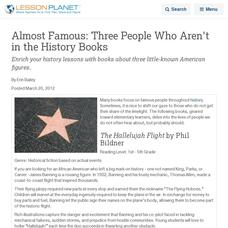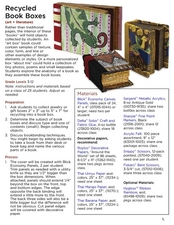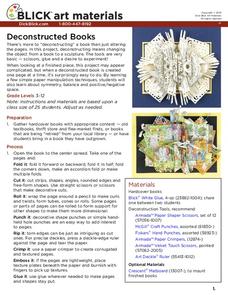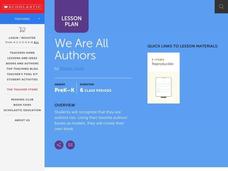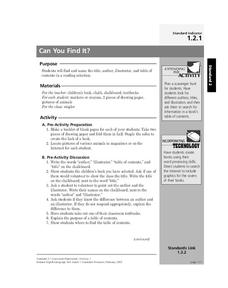Curated OER
Almost Famous: Three People Who Aren't in the History Books
Enrich your history lessons with books about three little known figures: Thomas Banning, Annie Taylor, and Tony Sarg.
Curated OER
Best Part of Me
After listening to the story, The Best Part of Me, learners will identify a positive physical feature of themselves, and create a descriptive poem about their favorite feature. Photographs are taken, and a nice final draft of the poem is...
Curated OER
Recycled Book Boxes
Your class can create colorful book boxes with recycled boxes. Versatile and fun, this project can be adapted to various lessons: book reports, history projecs, science collections, and more!
Curated OER
Books for Teaching "All About Me!"
Students learn about experiences and feelings through books. For this lesson, students read a variety of books to aid in their understanding of life. Through a listing and brief synopsis of twelve books, students explore feelings,...
Dick Blick Art Materials
Deconstructed Books
Scissors, glue, and an old book. Punches, crimpers, and rulers. Kids gather their tools and get set to create relief sculptures by deconstructing books.
Curated OER
Book Discussions in a Reading Partnership
Do you have a lot of different reading levels in your class? Pair kids up by level and have them choose a book to read independently. They will make predictions, ask questions, make connections, etc. Consider creating a general reading...
Curated OER
Dr. Seuss’s ABC: An Amazing Alphabet Book Lesson
Dr. Seuss's ABC Book is used to help young readers distinguish between the letters of the alphabet and their letter sounds. After a discussion reviewing the letters that are vowels and consonants, the book is read to the class. Then, the...
Curated OER
Create A Book to Enhance Learning of Important Life Skills
Help your learners gain valuable knowledge about life by creating a useful book that everyone can benefit from!
National Geographic
Plant Life
Looking for a guide to pair with non-fiction concept books? Intended to go with science-based leveled text mentioned in the resource, a unit allows for the study of plant life while enhancing academic vocabulary, language skills, and...
Curated OER
The Book Thief: Discussion Questions
Expand your study of The Book Thief by Markus Zusak with a question for each level of Bloom's Taxonomy. These questions focus on part four of the novel; each is paired with at least one quote from the text for context and teacher...
BW Walch
Daily Warm-Ups: Grammar and Usage
If grammar practice is anywhere in your curriculum, you must check out an extensive collection of warm-up activities for language arts! Each page focuses on a different concept, from parts of speech to verbals, and provides review...
Curated OER
We Are All Authors
Read and discuss a variety of books by different authors and have your class create their own book. They will identify the different parts of a book, then using a story they have already written, they enter their story and information...
Curated OER
Can You Find It?
Plan a Parts of a Book scavenger hunt. Begin by giving your young adventurers a book, and asking them to find the title, author, illustrator, and table of contents. After a discussion of the purpose of each of these items, class members...
Curated OER
Identifying Text Features of a Self-Written Fable
Make learning the parts of a book fun by having pupils construct their own glossary entries, table of contents, and title page. Beginning with a review of text features and a hunt for examples, kids use previously written fables to...
Curated OER
Letter Sound and Letter Combination Accuracy: Sound Matching Adjectives
Kindergartenrs explore English by analyzing images in a picture book. This lesson on the parts of speech calls for young learners to view a picture book in class and describe characters, settings and objects with adjectives. Then, as a...
Curated OER
Introduce: Cause and Effect
Introduce beginning readers to cause and effect in a story by exploring it together. Learners make predictions about a book based on its cover, title, and a brief flip through the pages. They listen to an explanation of cause and...
EdHelper
George Washington's Socks by Elvira Woodruff
A solid, straightforward book report form is an excellent addition to your literature unit. Class members note the main characters, point of view, plot elements, and other important details from a story, adding their favorite part...
Curated OER
Let's Learn About Plants!
After listening to From Seed to Plant by Gail Gibbons, learners take a walk around their school looking for plants. They use digital cameras to photograph the plants, then construct a class book which has the identities of the plants,...
Curated OER
Non-Fiction Text Features
Distinguish between textual features of non-fiction in the book The Lewis and Clark Expedition and in the non-fiction story "Ta-Na-e-Ka." Third graders create posters and participate in group discussions to show their...
Curated OER
Responding to Literature
Your class will create a four section flip book and write titles for characters, setting, problem, and solution. They will also draw a picture to show what they wrote about.
Curated OER
Sponge Painting Flowers
Explore the shapes and colors of spring with a flower themed painting project. Included here are a list of materials and the instructions needed to execute an art lesson on sponge painting flowers. Tip: Use in conjunction with a flower...
K12 Reader
Adverb Clauses in Sentences
If you'd like your class to write in varied sentence patterns, use a instructional activity focused on adverb clauses to enhance their writing. After reading a short explanation and example of adverb clauses, young grammarians underline...
Tech4Learning
Fantastic Fractions
Learners study how shapes can be divided into equal parts, that each part be equal to its counterpart, and combining parts equals one whole. They make the shapes out of modeling clay and take digital pictures of its parts to create an...
Curated OER
Flower Dissection
In this science worksheet, students follow directions for dissecting a flower. Students tape the parts of the flower in the corresponding boxes. Students also read about how flowers reproduce and analyze a related diagram.
Other popular searches
- Book Parts
- Book Parts Lesson
- "Book Review" Parts Format
- Identify Parts of a Book
- Using Book Parts
- "Book Review" Parts
- Smart Board Book Parts
- Main Book Parts
- The Book Parts
- Using Parts of a Book
- Parts of a Book Synopsis
- Non Futon Book Parts
